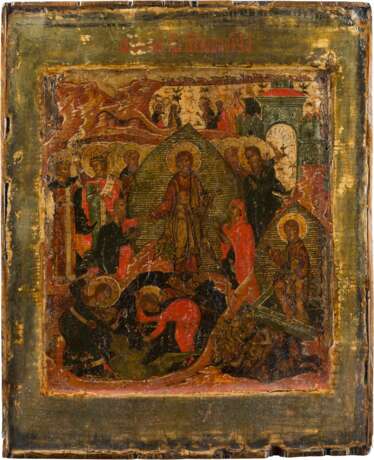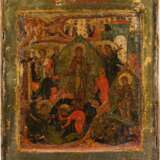A FINE ICON OF THE RESURRECTION FROM THE TOMB AND THE DESCENT INTO HELL
10.11.2017 11:00UTC +02:00
Classic
Starting price
4500EUR € 4 500
| Auctioneer | Hargesheimer Kunstauktionen Düsseldorf |
|---|---|
| Event location | Germany, Düsseldorf |
| Buyer Premium | 28.56% |
Archive
The auction is completed. No bids can be placed anymore.

ID 10470
Lot 674 | A FINE ICON OF THE RESURRECTION FROM THE TOMB AND THE DESCENT INTO HELL
Tempera on wood panel with double kovcheg. This icon is an example of the complex version of the Resurrection of Christ, presenting a combination of the iconography of the Descent into Hell and the Resurrection from the Tomb, which first appeared in Russian art in the early 17th century. In both scenes Christ is shown surrounded by a mandorla (representing shining light and glory). The right part of the panel presents the Resurrection scene with Jesus standing on his closed tomb, his hands raised in a benedictory gesture. The middle portion of the composition depicts the Descent into Hell, showing Christ holding a scroll symbolizing his victory over death, trampling upon the broken gates to hell. Christ is depicted descending into the inferno, welcoming a group of righteous men dressed in white, walking up from the bottom left corner towards him. To his left is a kneeling figure of Adam rising from the dead, whom the Savior is leading by the hand. This scene illustrates the main event of the Gospel when the Savior redeemed the first man. For as in Adam all die, so in Christ all will be made alive. On the bottom of the composition are two sleeping Roman soldiers uniting both scenes
| Address of auction |
Hargesheimer Kunstauktionen Düsseldorf Friedrich-Ebert-Strasse 11+12 40210 Düsseldorf Germany | ||||||||||||||
|---|---|---|---|---|---|---|---|---|---|---|---|---|---|---|---|
| Preview |
| ||||||||||||||
| Phone | +49 (0) 2113020010 | ||||||||||||||
| Fax | +49 (0) 21130200119 | ||||||||||||||
| Buyer Premium | 28.56% | ||||||||||||||
| Conditions of purchase | Conditions of purchase | ||||||||||||||
| Shipping |
Postal service pickup by yourself | ||||||||||||||
| Payment methods |
Wire Transfer | ||||||||||||||
| Business hours | Business hours
|



